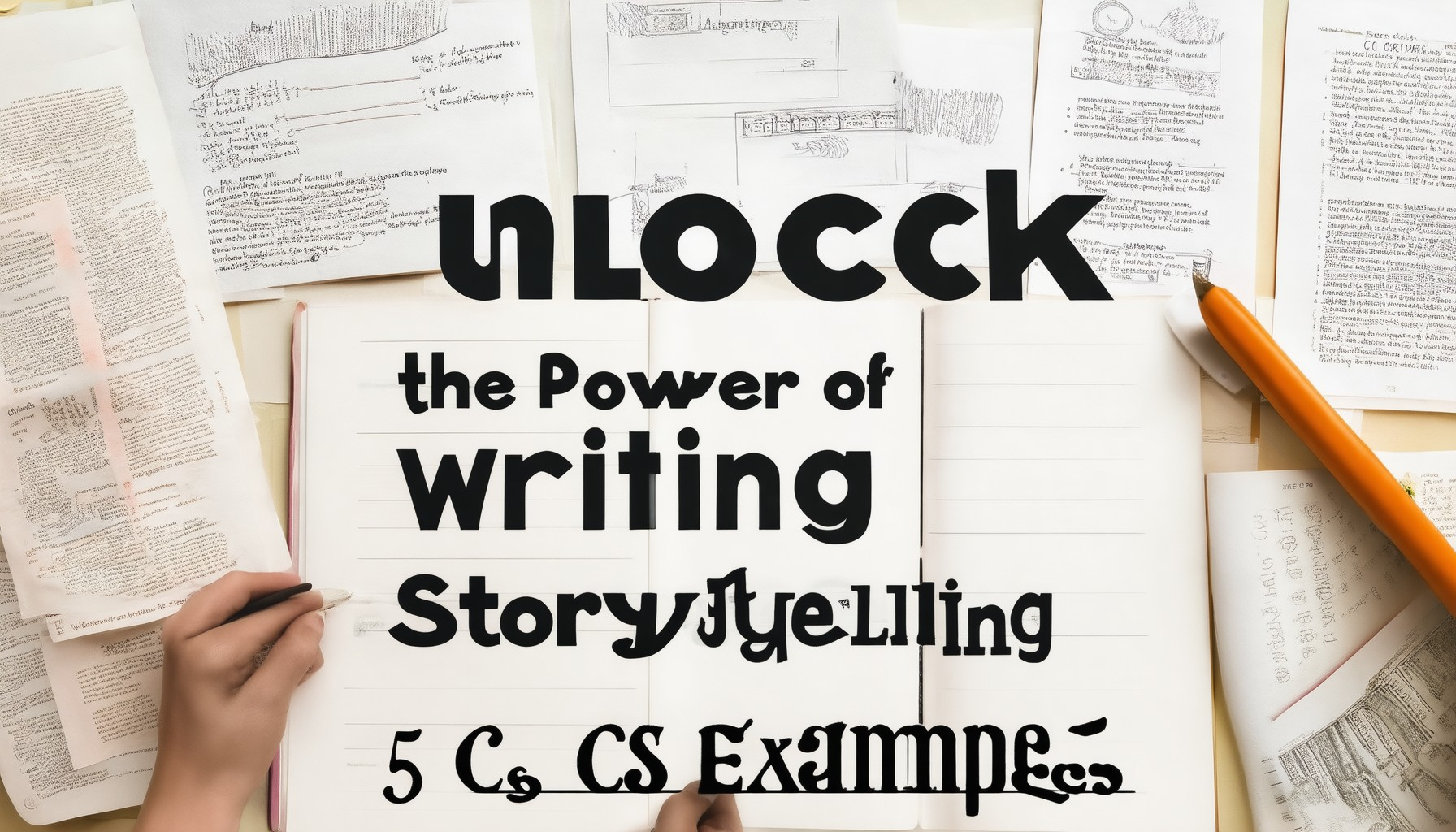Storytelling is a powerful art form that transcends mere entertainment, playing a crucial role in shaping narratives across various disciplines. Whether crafting novels, articles, marketing copy, or speeches, effective storytelling enables writers to captivate audiences, convey complex ideas, and leave lasting impressions. In this comprehensive guide, we delve into the essential components of storytelling, exploring the 5 Cs and 5 Ps that form the backbone of compelling narratives. From understanding the golden rule of showing, not telling, to leveraging the four types of storytelling, this article offers actionable insights and practical examples to help you master the art of writing for storytelling. Discover how to structure your stories, engage your readers, and craft messages that resonate long after the final page.
Key Takeaways
– Master the 4 Types of Storytelling: From personal anecdotes to business narratives, understand the diverse storytelling techniques to suit your needs.
– Apply the Golden Rule of Storytelling: Show, don’t tell, to create immersive, relatable, and emotionally resonant narratives.
– Leverage the 4 Pillars of Storytelling: Develop compelling characters, settings, themes, and plots to craft engaging and meaningful stories.

The Five Cs of Storytelling
Telling a compelling story involves mastering five key elements, often referred to as the “Five Cs” of storytelling. These elements work together to create engaging, memorable narratives:
- Character : Develop well-defined characters who drive the plot forward. Understanding their motivations, flaws, and growth is essential for creating relatable and compelling figures.
- Context : Establish a clear setting and background that provides context for the story. This includes the time period, location, and cultural environment.
- Conflict : Introduce a central conflict or problem that the protagonist must resolve. This creates tension and keeps the audience invested.
- Climax : Build up to a pivotal moment or turning point known as the climax. This is where the major confrontation occurs, leading to significant changes in the story.
- Closure : Conclude the story satisfactorily, resolving any loose ends and leaving the audience with a sense of completion or reflection.
By focusing on these five elements, storytellers can craft narratives that captivate audiences, evoke emotions, and leave a lasting impact.
How to Write Storytelling
Telling a story effectively requires a combination of creativity, structure, and emotional connection. Here’s a step-by-step guide to crafting compelling narratives:
1. Understand the Basics of Storytelling
Storytelling is the art of conveying ideas, emotions, and experiences through sequential narratives. A well-told story engages readers, evokes emotions, and leaves a lasting impression.
2. Plan Your Story
Before you start writing, develop a clear plan to guide your narrative:
- Develop a Plot: Outline the main conflict, climax, and resolution. Use tools like the Hero’s Journey framework to structure your story.
- Create Memorable Characters: Define your protagonist, antagonist, and supporting cast. Give them distinct traits and motivations.
- Set the Scene: Choose a setting that enhances your story. Whether it’s a historical era, futuristic world, or imaginary landscape, make it feel real.
3. Draft Your Story
Writing is where your ideas come to life. Focus on these elements to bring your story to paper:
- Write a Strong Opening: Grab attention with a hook—whether it’s a surprising fact, a vivid scene, or a thought-provoking statement.
- Describe Scenes Vividly: Use sensory details to paint pictures in your reader’s mind. Include sights, sounds, smells, and textures.
- Convey Emotions Skillfully: Show, don’t tell, how characters feel. Use dialogue, actions, and descriptions to reveal emotions.
4. Revise and Edit
Your first draft is just a blueprint. Refining it will make your story shine:
- Polish Dialogue: Ensure conversations sound natural and reveal character traits.
- Tighten Pacing: Maintain a steady rhythm, avoiding slow parts that lose the reader’s interest.
- Ensure Consistency: Keep settings, character behaviors, and tones consistent throughout the story.
5. Add Final Touches
Before finalizing, review your work to ensure it resonates with your audience:
- Read Aloud: Hearing your story can highlight awkward phrasing or areas needing clarification.
- Get Feedback: Share your story with trusted readers or writing groups to gain fresh perspectives.
- Understand Your Audience: Tailor your narrative to the preferences and interests of your intended readers.
6. Publish and Share
Once your story is ready, share it with the world. Consider publishing it online, in print, or through community platforms:
- Upload to Platforms: Share your story on blogs, literary websites, or social media platforms.
- Engage Readers: Respond to comments and feedback to foster a connection with your audience.
- Build a Following: Create a portfolio or website to showcase your work and attract more readers.
By following these steps, you can craft stories that captivate audiences and leave a lasting impact. Remember, storytelling is a journey—keep experimenting, learning, and growing to become a master of the craft.
For more tips on refining your storytelling skills, explore our guide to improving your narrative and discover how to create compelling characters and plots that resonate with readers.

The 5 P’s of Storytelling
The 5 P’s of storytelling are a simple yet effective framework to create engaging and memorable narratives. These elements work together to captivate audiences and leave a lasting impact. Here’s a breakdown of each component:
- People : At the heart of every great story are relatable and multifaceted characters. Develop protagonists and antagonists who drive the plot forward and resonate with your audience.
- Place : Setting plays a crucial role in shaping the tone and mood of your story. Whether it’s a bustling city or a serene village, the environment should feel authentic and immersive.
- Pictures : Visual descriptions are key to painting a vivid picture in the reader’s mind. Use sensory details to bring scenes to life and help your audience visualize the story world.
- Personalization : Tailor your story to connect with the audience on a personal level. This could mean showing the protagonist’s emotions, motivations, or struggles in a way that feels genuine.
- Peril : Every compelling story needs conflict or tension. Introduce challenges, dilemmas, or stakes that push your characters and keep the narrative moving forward.
These elements work together to create stories that are not only entertaining but also emotionally resonant. By focusing on people, places, pictures, personalization, and peril, you can craft tales that capture attention and inspire action.

What Are the 4 Types of Storytelling?
Storytelling is a powerful tool used across various industries to convey ideas, emotions, and experiences. Below are the four primary types of storytelling:
- 1. Personal Storytelling : This type focuses on sharing personal experiences, thoughts, and feelings. It is often used in blogs, diaries, or social media posts to connect with others on a human level.
- 2. Historical Storytelling : This involves recounting events from the past, often with a focus on historical figures, events, or movements. It is commonly found in textbooks, documentaries, and educational materials.
- 3. Fictional Storytelling : This type is imaginative and creative, involving made-up characters, plots, and worlds. Novels, movies, and video games are common platforms for fictional storytelling.
- 4. Business Storytelling : In this context, stories are used to communicate the mission, values, and goals of a company. They often aim to inspire employees, customers, and stakeholders while fostering a sense of connection and purpose.
Each type of storytelling serves a unique purpose and can be adapted to different audiences and scenarios. Whether personal, historical, fictional, or business-oriented, storytelling remains a versatile medium for communication and engagement.
The Golden Rule of Storytelling
The golden rule of storytelling is often referred to as “show, don’t tell.” This principle emphasizes the importance of conveying ideas and emotions through actions, descriptions, and sensory details rather than directly stating them. By focusing on what can be seen, heard, felt, or experienced, authors create a more immersive and relatable narrative for their audience.
This approach enhances engagement by allowing readers to connect with the story on a deeper level. Instead of relying on exposition or explicit statements, the narrative becomes a window into the characters’ lives and the world they inhabit. Here’s why “show, don’t tell” is so essential:
- Immersive Experiences: By showing rather than telling, stories become more vivid and memorable. Readers can visualize scenes, empathize with characters, and feel the emotional weight of the story.
- Character Depth: Showing allows authors to reveal character traits and motivations organically through their actions and interactions, making characters more believable and compelling.
- Cultural and Emotional Resonance: Stories that show rather than tell resonate more deeply with audiences because they tap into universal human experiences and emotions.
To illustrate this concept, consider a scene where a character is nervous about an important event. Instead of stating, “John was nervous,” the author might describe his fidgeting, sweating palms, and hesitant demeanor. These details allow readers to infer John’s anxiety without being told outright.
In addition to enhancing storytelling, this technique also improves SEO performance by providing rich, descriptive content that aligns with search engine algorithms. By focusing on sensory details and actions, authors create content that is more likely to rank highly in search results.
At JamesWhitfieldThomson.com, we believe in the power of storytelling to educate, inspire, and entertain. Our platform offers resources and insights to help writers master the art of showing, not telling, ensuring their work captivates and engages readers on a profound level. Explore our articles, tutorials, and community discussions to discover how to apply this golden rule in your own writing.

What are the 4 P’s of storytelling?
The 4 Pillars of Storytelling are fundamental concepts that help structure effective narratives across various mediums. These pillars work together to create engaging, memorable, and impactful stories.
- People: The heart of any story lies in its characters. People include the protagonist, antagonist, supporting characters, and even minor figures who play significant roles. Developing relatable and multifaceted characters is crucial for connecting with audiences.
- Places: Settings or locations play a vital role in shaping the story’s tone and atmosphere. Whether it’s a bustling city, a serene forest, or a mysterious castle, the setting often mirrors the emotional journey of the characters.
- Purpose: Every great story has a central purpose or theme. This could be a quest for adventure, a journey of self-discovery, or exploring complex social issues. The purpose drives the narrative forward and gives it meaning.
- Plot: The plot is the sequence of events that unfold, leading to conflict, climax, and resolution. A well-crafted plot keeps readers engaged, maintains suspense, and ultimately delivers a satisfying conclusion.
Understanding and leveraging these four pillars allows storytellers to craft compelling narratives that resonate with audiences. By focusing on the interplay between these elements, creators can build stories that are not only entertaining but also deeply meaningful.
For more insights into storytelling techniques and to explore practical advice for writers, visit James Whitfield Thomson .





0 Comments